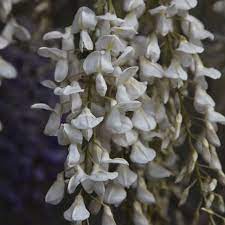Wisteria is a genus of flowering plants that are best known for their stunning and fragrant cascading clusters of flowers. These deciduous vines or shrubs belong to the pea family (Fabaceae) and are widely cultivated for their ornamental appeal. Here are key features and information about Wisteria:
Key Characteristics:
Flowers:
Wisteria is renowned for its long, pendulous clusters of pea-like flowers.
The flowers come in various colors, including shades of purple, blue, pink, and white, depending on the species and cultivar.
Foliage:
The compound leaves are composed of multiple leaflets that are arranged alternately along the stem.
The foliage provides a lush backdrop to the vibrant flowers.
Growth Habit:
Wisteria is a climbing vine that uses twining stems to ascend structures such as trellises, arbors, and pergolas.
Some varieties are more shrub-like and can be trained as free-standing plants.
Fragrance:
Many wisteria varieties have a delightful fragrance that adds to their overall charm.
The scent is often described as sweet and reminiscent of grapes.
Blooming Season:
Wisteria typically blooms in late spring to early summer, producing a spectacular display of flowers.
Size:
The size of wisteria plants can vary, with some reaching substantial heights and widths, especially when mature.
Common Types:
Chinese Wisteria (Wisteria sinensis):
Native to China, this species is characterized by its long clusters of fragrant, violet-blue flowers.
It is one of the most commonly cultivated wisteria varieties.
Japanese Wisteria (Wisteria floribunda):
Native to Japan, it features longer flower clusters and is available in a variety of colors, including violet, blue, pink, and white.
American Wisteria (Wisteria frutescens):
Native to the southeastern United States, this species is generally more restrained in its growth compared to Chinese and Japanese wisteria.
Growing Tips:
Sunlight: Wisteria thrives in full sun but can tolerate partial shade.
Soil: Well-draining soil is crucial. Wisteria prefers fertile, slightly acidic to neutral soil.
Watering: Provide regular watering, especially during dry periods. Once established, wisteria is relatively drought-tolerant.
Pruning: Regular pruning is essential to control its vigorous growth and encourage the development of flowering spurs. Prune after flowering.
Support: As a climbing plant, wisteria requires support structures like trellises or arbors. Ensure the support is sturdy enough to bear the weight of the mature plant.
Caution:
Invasive Potential: Some wisteria varieties, particularly the Chinese and Japanese types, can be invasive in certain regions. It’s important to choose non-invasive varieties or take steps to control their spread.
Wisteria is prized for its breathtaking floral display and can become a focal point in gardens and landscapes. Proper care, including regular pruning and attention to its support structure, helps ensure a healthy and vibrant wisteria plant.









Reviews
There are no reviews yet.